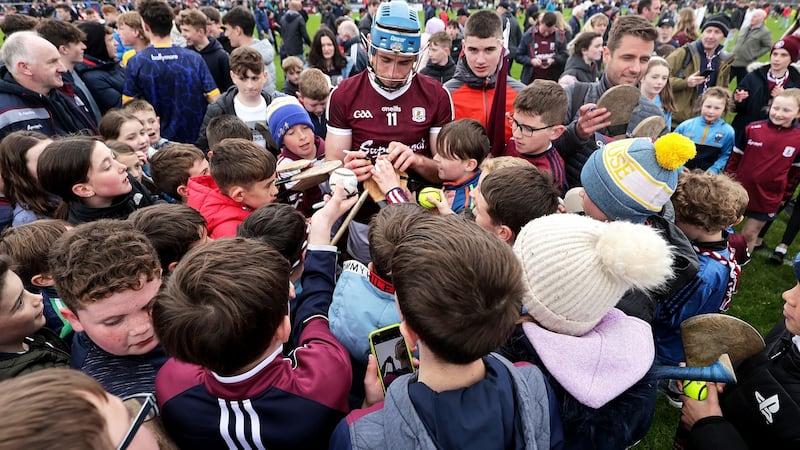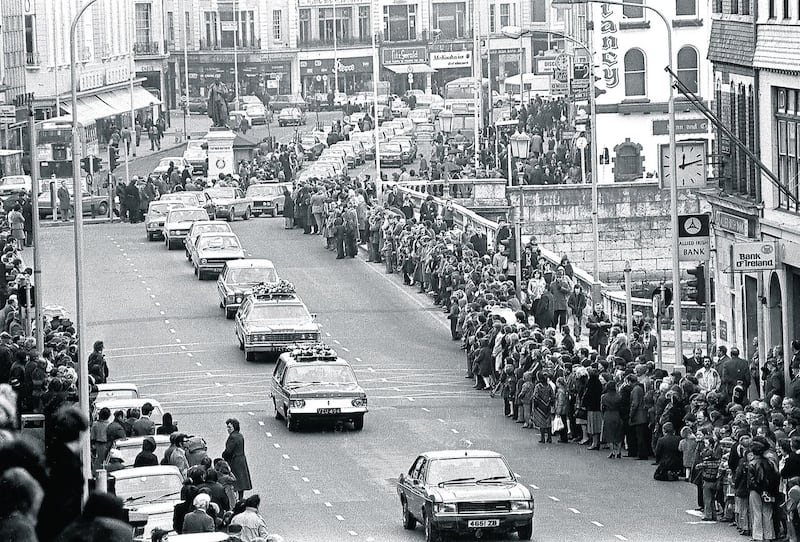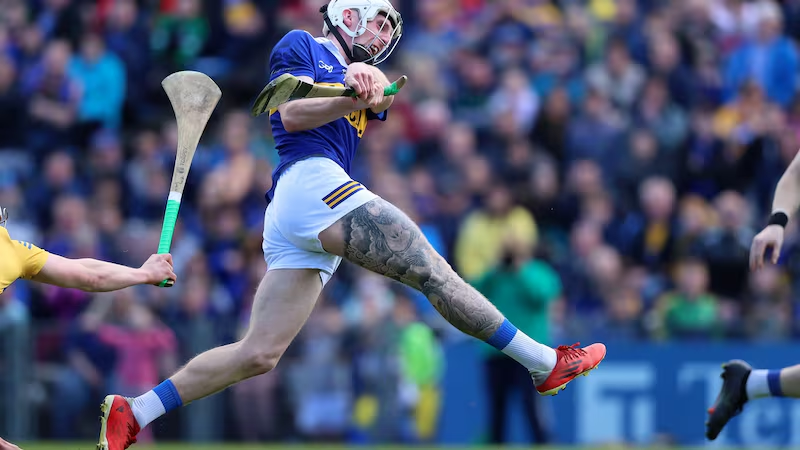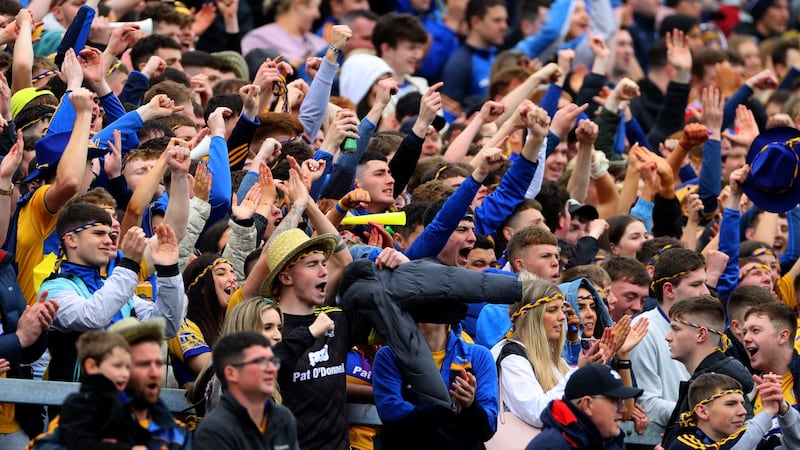The story of Christy Ring’s final walk across the pitch in Croke Park has a melancholy shade. It was a few hours after the 1978 All-Ireland hurling final. “In the fading light of the September evening he searched about with little confidence for a presentation watch which fell from his wrist when, as a selector, he rushed out to greet the Cork team which had beaten Kilkenny in the All-Ireland final,” reported Val Dorgan in Christy Ring, the strange, gorgeous biography he wrote about his former team-mate and friend.
Anyone who has lingered in Croke Park after the traditional September All-Ireland finals will have experienced a singular sense of the season turning autumnal: the place empties quickly; night descends on the city and, after the heightened scenes and sounds of the match, the stadium quickly falls under an extraordinary nocturnal peace. There is something unforgettable about the idea of Ring alone on the field that evening, in the shirt and tie of a mortal.
“The watch was given to him for 25 years of service with Irish Shell and he had worn it for the first time that weekend,” continued Dorgan. “He told nobody at the time about his loss, and never did find the watch. It was the last time he walked Croke park, on which he had won 18 Railway Cup medals and eight All-Irelands. He died on March 2, 1979, aged 58.”
It would be fascinating to know what Ring would make of the carefully calibrated possession-and-pressing game which hurling has become
It is probable that no Gaelic games star will ever touch the degree of true fame and mythology which Ring achieved through his reputation as a hurler and his longevity. His Cork career spanned four decades, between 1939 and 1962. Although he played when Gaelic games were seldom on television and the concepts of marketing and advertising were in the future of the association, Ring regularly batted away name-your-price interview offers from London and even American newspapers and magazines. On one of his frequent tours to New York, a group of businessman proposed he give his name to a Manhattan bar. They'd run it. He'd pocket half of the profits. He laughed them off. The Christy Ring presented by Dorgan is an elusive, complex figure, shy and loyal and as masterful with the mordant one-liner as with the hurl. ("Do you know what he'll be doing next?" he said of a reputedly short-sighted attacking player. "He'll be listening for the ball.")
He was no nostalgist when it came to the qualities of hurling, famously declaring that the best was yet to come. As the GAA flipped into the new millennium, the landscape through which Ring strode has changed enormously. It would be fascinating to know what he would make of the carefully calibrated possession-and-pressing game which hurling has become. And while Ring was physically powerful, he would doubtlessly marvel at the size and conditioning of many of the game’s current stars. And he might be surprised, too, at the radical calendar alterations which now dictate the GAA schedule.
This is just the second weekend in May and already the All-Ireland hurling and football championships are travelling at a rate of knots. There have been some magnificent games – witness the hurling clash of Kilkenny and Galway last weekend or the riveting penalty shoot-out between the footballers of Clare and Limerick. But there is an undeniably discordant atmosphere about the whole show. It feels rushed. The weather is still quite cool. The hazy heat of championship days – 99 weather – is part of the Irish DNA. The tournament seemed to start without any real fanfare. Indeed, the build-up was fractious, with a stand-off between the GAA and the Gaelic Players Association, founded in 1999.

Anyone paying scant attention – which counts for most – might have assumed it was just another GAA row over money. In fact, the disagreement got to the heart of an abiding tension at the elite level of Gaelic games right now. The players' association, after agreeing to a significant cut in expenses during the pandemic seasons, sought a reinstatement of the charter operating in 2019 and were unhappy at the GAA's offer of expenses to cover training or match expenses of up to four per week. Anything beyond that would not be processed in the centralised cash-flow arrangement that sees Croke Park expedite payment of expenses. But, as the GPA's chief executive Tom Parsons saw it, the offer compromised the basic privileges of players to go about the season without actually losing money.
“Some parts of the season you might need to train five times or maybe six if you are doing a workshop on a Saturday,” he said at the time. “Other times, it might be three. That is the solution to this. The charter should set out what is the rate all players should receive going to collective sessions. It is a very simple model. You are reimbursed for expenses you incur. It is a mark of respect. Players felt very aggrieved that that wasn’t honoured. What frustrated players is that we know the caps were introduced as a cost-saving measure.”
The disagreement produced a diffuse set of opinions and obvious questions. The GAA is supposed to be amateur; how could teams train or get together six times a week?
"What the GPA wants is unlimited expenses for whatever number of sessions," Colm O'Rourke, the former Meath star, told Joanne Cantwell during an RTÉ debate on the subject.
“And I don’t think . . . that’s a move to semi-professionalism. I think the offer is generous. And when I look at the whole GAA and what the Tom is saying about the money being made in the inter-county game, nobody wants to see players – particularly students – out of pocket. Tom is saying they don’t get anything for it. Well, they get the enjoyment of doing it, the health benefits and the privilege of playing in big games in Croke Park. And when I look at the GAA, it is a huge organisation. Ninety-seven per cent of it is club players who travel up and down the country and oftentimes get no expenses at all.
That quest for the winning edge, coupled with radical improvements in sports science knowledge, has transformed the profile of every county team
“So, in many ways the county players are a privileged group and it does appear as if the GPA, because they are not getting their own way, have thrown the toys out of the pram.”
Many of the GAA’s half a million members would sympathise with O’Rourke’s view. Don’t other elite amateur sportspeople devote untold hours while living spartan lifestyles? Is this not the lot of aspiring Olympic athletes and boxers and rowers? With none of the acclaim or expenses? Isn’t playing for your county the ultimate honour?
Every generation of county stars trained seriously – although there are still clips of victorious teams sparking up tobacco on the steps of the Hogan stand. And it’s clear, from the yarns, that those older teams had more time for fun. The fun of playing county ball has disappeared not by any design but rather because of the respective pride and ambition within all county teams. That quest for the winning edge, coupled with radical improvements in sports science knowledge, has transformed the profile of every county team through the divisions. Trawl the store of GAA managerial cliches (and it is a vast, vast databank) and you will repeatedly have losing managers concede that they are in a “results business”. It is easy to chart the incremental leaps in physical and tactical improvements summer after summer.

And if county players are expected to give that level of commitment, how is it sustainable? A GPA survey from 2018 did not present a very rosy picture of the life of a GAA inter-county player, with 80 per cent of respondents stating that playing for the county placed a strain on their family life. Elite GAA is a young man’s game: 30 per cent are in college; a further 30 per cent are recent graduates. The time demands between club and county commitments are unflagging. And the All-Ireland championships generate serious money. In 2018, the GAA announced revenue of €63 million. That increased to €73.9 million in 2019, with a 22 per cent rise in gate receipts and a 12 per cent rise in match attendances. Gate receipts contribute almost half of the GAA’s total revenue. So it is understandable that the star draws – the players – would feel aggrieved at the idea of being short-changed when it came to mere expenses.
A resolution was quietly reached between both parties in mid-April. But the tug-of-war between the players’ and parent bodies will continue. The GPA has never fully escaped initial suspicions that it is slowly advancing a movement towards professionalism within the GAA, despite repeated clarifications from successive heads to the contrary. The code of amateurism is sacrosanct to the identity of the GAA. The vast majority of members, from club volunteers to high-profile managers and players, are usually dismissive and often hostile towards the idea.
Yet part of the fun and gossip of any GAA season is speculation about how much such-and-such a manager is on with whatever team. It is generally accepted that while players are not remunerated for their efforts, the story is more nuanced when it comes to managers. If this is the case, can the GAA still claim to even be an amateur organisation? Sums of €80,000-€100,000 per annum are commonly mentioned. But it is all second- and third-hand sources offered with the usual qualifications: “That’s what I heard.” “That’s what they are supposed to be on.”
“It’s nonsense,” says one former inter-county manager.
“The logistics of trying to come up with that kind of money and having it paid over in a way that is manageable would be very difficult,” says one former county manager. “If there are 20 managers in the country making that, that’s the height of it. It is mileage plus the deficit, if there is one, paid in cash. If you look at it purely from numbers, it is 99.9 percent an amateur sport.

“The real idea of professionalism has come in at the inter-county side of things, even though there are many clubs that also have a certain degree of professionalism, which tends to be in the backroom side of things – physios and strength coaches and catering. And if you decide to go with an ‘outside’ manager, you are going to have to remunerate them somehow. And it is done through mileage. But most clubs are managed by someone locally and there is nothing involved.”
The idea of the GAA someday turning professional is nothing new. But it is increasingly dismissed. During the pandemic, Ulster council secretary Brian McEvoy observed that the financial impact “has totally put to bed any argument that the GAA could sustain any sort of amateur body. That argument’s dead; it always was dead but for those that needed convincing, they don’t need convincing now. If they do, they’re living in cloud cuckoo land.”
At its core, the Corinthian spirit is alive within the GAA. The games at their best will be thrilling, brilliant
Financial viability is not the only reason why most believe that professionalisation could not work. Professional games would inevitably bring an end to the prevailing competitive structure of county versus county. And that’s the magic dust which has sustained the championships for over a century. Scroll the All-Ireland honours list and it soon becomes clear that the competition favours the strong. A famous minority have the monopoly on provincial and All-Ireland title wins. The vast majority of inter-county GAA players give a decade or more of their lives to playing for their county without ever winning anything, ever. And yet the basic furnace of energy behind the stress of volunteer county boards fronting efforts to field county teams which can cost, at the elite end, up to €1 million to operate, originates in an unreasonable love of one’s county. All of that behind-the-scenes work – the underage coaching, the ticket-selling, the stadium-building – is reflected in the jaw-dropping spectacle of All-Ireland championship games at their best. It’s about playing the games, yes. But it’s also about the preservation of something sacred.
The source of the recent tension between the GPA and GAA was explored in a forensic ESRI study commissioned by both bodies in 2019. The results paint a picture of what happens to the best young GAA stars when they make the transition from club and minor stardom to a fledgling senior career. Their college courses are frequently chosen because those courses allow them to give time to commit to the inter-county demands. Some 26 per cent worked in education as opposed to 4 per cent of the general population. Just 11 per cent worked in skilled trades, as opposed to 18 per cent of the general population. And while 95 per cent were employed, just 5 per cent worked for themselves.
Half the Division One respondents said they took jobs because those jobs would allow them to train and play. Over 60 per cent acknowledged their status as county players helped them obtain jobs. Issues such as season length, time and enjoyment were chief among their concerns. Over half felt that being inter-county players made their lives “better”. But a significant number of respondents bemoaned the lack of fun.
“Scale it back. Commitment, time and professional standard-setting has gone too far,” returned one player. “Enjoyment is leaving the game.”

And it’s true: the fun of high-octane championship days is confined to those of us in the crowd on match days. The stars themselves live extraordinarily ascetic lives during the high season; the vast majority of players treat their role as a vocation. They play in front of 40,000-80,000 people and in front of vast television audiences. They are under enormous scrutiny. The essential truth that nobody is forcing the players to commit is true. They can just leave. But worryingly, several high-profile stars have done just that at the peak of their powers.
So what we will witness this weekend and right through until July is a revered tradition in Irish life which has somehow been catapulted into a place that nobody – not the administrators, not the coaches, not the players – can fully explain or understand. Elite players are operating at the absolute edge of amateur possibility. What was a moseying three-month carnival serving as a backdrop to Irish summers now has an accelerated let’s-get-it-out-of-the-way feel about it. September, always the GAA’s golden month, is now nothing special on the re-drawn calendar.
At its core, the Corinthian spirit is alive within the GAA. The games at their best will be thrilling, brilliant. Today’s stars still inhabit the role of which Christy Ring remains the archetype: a god in the eyes of children and, when they grow up, an enduring symbol of the best of it. The enduring popularity of Ireland’s national games is a wonder. And that the All-Ireland championship – all of this effort and commitment for the almost-impossible quest of lifting two big silver cups – has not just survived but blossomed while preserving its volunteer ethos is a form of genuine magic.
And the delicate part is: that magic only works if everyone believes in it.


















